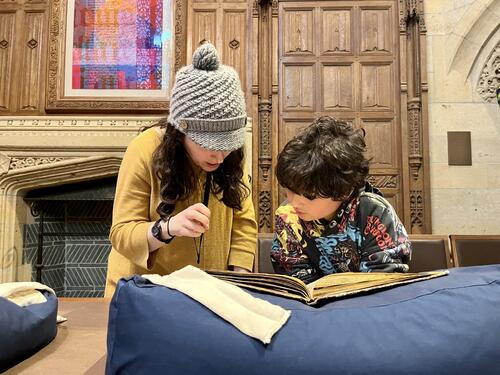
A number of haggadot and Passover-related books from Yale’s collections were on view for students, faculty and visitors on Wednesday afternoon in the Gates Classroom at Sterling.
The pop-up exhibition, co-hosted by the Program in Jewish Studies and the Chaplain’s Office, and curated by professor Sarit Kattan Gribetz and Jewish Studies librarian Konstanze Kunst, displayed haggadot — the traditional book read at Passover — from across many centuries and countries, showcasing Jewish history and tradition in advance of the holiday of Passover.
“I wanted to bring people together around a shared topic of learning, so that people would be able to come together and each learn something new that they didn’t know when they walked in,” Gribetz said. “How do you create a community around learning and books and holidays?”
Gribetz began planning this event a few months ago, after attending a meeting with various student groups and the chaplain’s office about the upcoming holiday of Passover.
In the exhibit, by using historical materials from Jewish communities around the world, including Italy, Amsterdam, North Africa and Russia, she hoped visitors would engage with a diverse set of traditions.
“There’s something very powerful about seeing and coming into direct contact with artifacts from the past,” Gribetz said. “There’s something different about seeing a medieval manuscript or rare book in person, rather than seeing it on a computer screen or in a printed book. That’s why the amazing resources at the library can be very powerful for sparking academic interest and curiosity.”
Gribetz found the partnership between faculty, librarians and graduate students meaningful while she was assembling the exhibit. The collaborative atmosphere, where different groups are encouraged to participate and contribute to projects such as this one, creates an inclusive community that she values.
Ruth Foster GRD ’30, a first-year doctoral student seeking a religious studies degree, presented information for visitors about two modern “art haggadot” from Israel at the exhibit. The pages were full of richly colored art depicting the Passover story.
“Even though, historically and geographically, there are different interpretations of the Exodus story, there’s also an inherent intertextuality to all of [the haggadot], because they’re telling the same story and using the same images,” Foster said, “even if one is from Amsterdam in the 18th century and one is from Haifa in the 21st century.”
Foster finds the haggadot interesting to compare, because each of them is responding to the moment in which they were created, reflecting various traditions and ideologies.
Among the other haggadot in the room were ones from 18th-century Amsterdam, Communist Russia and one created by Holocaust survivors.
On the other side of the room, Beinecke Rare Book and Manuscript Library curator Agnieszka Rec showed visitors a Latin medieval manuscript. Not a haggadah like many of the artifacts in the room, this book told Christian medieval communities how to calculate the date of Easter depending on the date of Passover.
The manuscript showcased the interaction between different religious communities in the medieval era.
“A lot of medieval Latin manuscripts talk about Judaism in extremely negative terms,” Rec said. However, this manuscript demonstrates the constructive ways that Christian communities interacted with Judaism, which she values.
Daniel Dumontet ’28 came to the exhibit because he took a class with Gribetz last semester.
“A lot of the time, it seems like the holidays and religious texts in Judaism are insurmountable in their tradition,” Dumontet said, “and yet something like [this exhibit] shows that it’s actually a very alive religion that we can all make our own and draw historical lessons from.”
The haggadah created by Holocaust survivors stood out to Dumontet. He found the expressive drawings in the book very meaningful and thought they evoked emotions similar to those of the ancient Israelites fleeing Egypt in the Passover story.
Gribetz thinks that over time, Passover has become a family holiday, with traditions unique to each group that celebrates it. At the same time, she said, it has a communal dimension.
“[Displaying the haggadot] creates a bridge between home, family and community, as well as learning and culture,” Gribetz said.
Passover begins April 12 at sundown.